Power Supplies
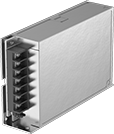
(Screw Terminal Input ×
Screw Terminal Output)
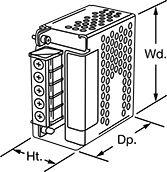
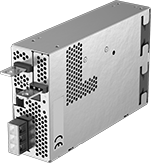
To power electronics ranging from simple prototypes to complex industrial automation and process control equipment, these general purpose power supplies convert AC to DC voltage. Mount them to a surface inside your device’s enclosure.
So you don’t accidentally touch internal components and shock yourself, these power supplies have their own housing. If you occasionally need to poke around inside your device’s enclosure, the housing also protects the power supplies themselves from damage. But compared to open-frame power supplies, these have a larger footprint, so they won’t fit in tight spaces.
For output wire connections, choose from standard screw terminals, screw-clamp terminals, and tab terminals. Use tab terminals if you have wires with ring terminal ends. To connect them, slide a screw through the hole in the tab terminal, slip the ring terminal from your wire over the screw, and tighten a nut on the end of the screw to hold everything in place. Screws, nuts, and ring terminals are not included.
All of these power supplies use switching regulation, which means they produce the stated voltage despite fluctuations in your input power and the power being drawn by your system, and they won’t become too hot. Power supplies that are SEMI F47 compliant meet standards for maintaining output voltage when input voltage dips. This is commonly known as voltage sag immunity.
If you exceed the maximum current, load, or voltage, these power supplies shut down to protect both the power supply and the connected equipment. All meet stringent safety standards.
Maximum output noise is also known as ripple noise. The lower the value, the less interference the power supply creates. For most applications, a value over 100mVpp isn’t a problem. However, when using to power extremely sensitive electronics, such as audio equipment and high-precision measuring and testing equipment, you’ll want an output noise around 5mVpp or less.
Power factor shows how effectively a power supply draws AC power from the main electrical supply. The higher the power factor—up to a maximum score of 1—the lower your operating cost.
Efficiency describes how good a power supply is at converting the AC power it draws from your main electrical supply into DC power. High-efficiency power supplies cost less money to operate and produce less heat, meaning cooler temperatures in your electrical cabinet.
Power supplies that cannot be sold to the regions listed are restricted by local energy efficiency requirements.
Output | ||||||||||||||
|---|---|---|---|---|---|---|---|---|---|---|---|---|---|---|
| Voltage (Voltage Adjustment) | Current, A | Power, W | Number of Power Connections | Max. Output Noise Peak-to-Peak, mV DC | Power Factor | Efficiency | Ht. | Wd. | Dp. | Protections Provided | Specifications Met | Cannot Be Sold To | Each | |
Single Phase—100V AC-240V AC Input Voltage | ||||||||||||||
Screw Terminals Input × Screw Terminals Output | ||||||||||||||
| 36V DC (32V DC-40V DC) | 0.75 | 27 | 1 | 150 | Not Rated | 84% @ 230 V AC | 1.1" | 2" | 3.1" | Overcurrent, Overload, Overvoltage | UL Recognized Component, C-UL Recognized Component, CE Marked | CA, VT | 00000000 | 000000 |
| 36V DC (32V DC-40V DC) | 1.4 | 50.4 | 1 | 150 | Not Rated | 86% @ 230 V AC | 1.4" | 3.8" | 3.9" | Overcurrent, Overload, Overvoltage | UL Recognized Component, C-UL Recognized Component, CE Marked | CA, VT | 00000000 | 00000 |
| 36V DC (32.4V DC-39.6V DC) | 2.8 | 100.8 | 1 | 200 | 0.9 @ 230 V AC, 0.98 @ 100 V AC, 0.98 @ 115 V AC | 86% @ 100 V AC 86% @ 115 V AC 89% @ 230 V AC | 1.6" | 3.8" | 4.3" | Overcurrent, Overload, Overvoltage | UL Recognized Component, C-UL Recognized Component, CE Marked, D Marked, SEMI F47 Compliant | CA, VT | 00000000 | 00000 |
| 36V DC (32.4V DC-39.6V DC) | 4.2 | 151.2 | 1 | 200 | 0.93 @ 230 V AC, 0.98 @ 100 V AC, 0.98 @ 115 V AC | 87% @ 100 V AC 87% @ 115 V AC 90% @ 230 V AC | 1.6" | 3.8" | 5.1" | Overcurrent, Overload, Overvoltage | UL Recognized Component, C-UL Recognized Component, CE Marked, D Marked, SEMI F47 Compliant | CA, VT | 00000000 | 000000 |
| 36V DC (32.4V DC-39.6V DC) | 8.4 | 302.4 | 2 | 200 | 0.95 @ 230 V AC, 0.98 @ 115 V AC, 0.99 @ 100 V AC | 83% @ 100 V AC 83% @ 115 V AC 87% @ 230 V AC | 1.6" | 4" | 7.5" | Overcurrent, Overload, Overvoltage | UL Recognized Component, C-UL Recognized Component, CE Marked, D Marked, SEMI F47 Compliant | __ | 00000000 | 000000 |
| 36V DC (32.4V DC-39.6V DC) | 16.7 | 601.2 | 2 | 200 | 0.95 @ 230 V AC, 0.98 @ 115 V AC, 0.99 @ 100 V AC | 85% @ 100 V AC 86% @ 115 V AC 88% @ 230 V AC | 2.4" | 4.7" | 7.5" | Overcurrent, Overload, Overvoltage | UL Recognized Component, C-UL Recognized Component, CE Marked, D Marked, SEMI F47 Compliant | __ | 00000000 | 000000 |
Screw Terminals Input × Tab Terminals Output | ||||||||||||||
| 36V DC (32.4V DC-39.6V DC) | 28 | 1,008 | 1 | 200 | 0.95 @ 230 V AC, 0.98 @ 100 V AC, 0.98 @ 115 V AC | 84% @ 100 V AC 85% @ 115 V AC 88% @ 230 V AC | 2.4" | 5.9" | 9.5" | Overcurrent, Overload, Overvoltage | UL Recognized Component, C-UL Recognized Component, CE Marked, D Marked, SEMI F47 Compliant | __ | 00000000 | 000000 |
| 36V DC (32.4V DC-39.6V DC) | 42 | 1,512 | 1 | 200 | 0.95 @ 230 V AC, 0.98 @ 100 V AC, 0.98 @ 115 V AC | 84% @ 100 V AC 85% @ 115 V AC 88% @ 230 V AC | 2.4" | 7" | 10.6" | Overcurrent, Overload, Overvoltage | UL Recognized Component, C-UL Recognized Component, CE Marked, D Marked, SEMI F47 Compliant | __ | 00000000 | 000000 |
Remote On/Off Power Supplies
Save power by switching these power supplies on and off remotely, so devices only run when they're needed. Use them to convert AC voltage to DC to power electronic equipment ranging from simple prototypes to complex industrial automation and process control equipment. Mount them to a surface inside your device’s enclosure.
Besides turning them on and off, these power supplies have two other remote capabilities. Remote voltage sensing lets them compensate for any voltage that’s lost as it travels across the wires, ensuring that devices get the correct voltage. They also send a signal if the voltage drops, the cooling fan fails, or they exceed the maximum current, load, voltage, or temperature.
To use the remote features of these power supplies, you’ll need a wire connector (sold separately). Eight pin connectors enable remote on/off, voltage sensing, and signaling functionality using the power supply’s auxiliary power output. Ten pin connectors only add remote on/off and voltage sensing functionality. They require an external power source, such as a battery or another power supply.
So you don’t accidentally touch internal components and shock yourself, these power supplies have their own housing. They're good to use in spots where you occasionally need to access the inside of your device’s enclosure, since the housing also protects the power supplies themselves.
For output wire connections, they have either standard screw terminals or tab terminals. Choose tab terminals if you have wires with ring terminal ends. To connect them, slide a screw through the hole in the tab terminal, slip the ring terminal from your wire over the screw, and tighten a nut on the end of the screw to hold everything in place. Screws, nuts, and ring terminals are not included.
All of these power supplies use switching regulation, which means they produce the stated voltage despite fluctuations in your input power and the power being drawn by your system, and they won’t become too hot. In addition to sending a signal, if you exceed the maximum current, load, voltage, or temperature, these power supplies shut down to protect both the power supply and the connected equipment.
They're UL and C-UL Recognized Components, TUV Rheinland Certified, and CE Marked so you know they meet stringent safety standards.
Maximum output noise is also known as ripple noise. The lower the value, the less interference the power supply creates. For most applications, a value over 100mVpp isn’t a problem. However, when using to power extremely sensitive electronics, such as audio equipment and high-precision measuring and testing equipment, you’ll want an output noise around 5mVpp or less.
Power factor shows how effectively a power supply draws AC power from the main electrical supply. The higher the power factor—up to a maximum score of 1—the lower your operating cost.
Efficiency describes how good a power supply is at converting the AC power it draws from your main electrical supply into DC power. High-efficiency power supplies cost less money to operate and produce less heat, meaning cooler temperatures in your electrical cabinet.
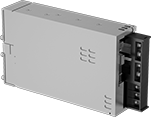
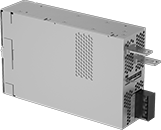
Output | |||||||||||
|---|---|---|---|---|---|---|---|---|---|---|---|
| Voltage (Adjustment Range) | Current, A | Power, W | Max. Output Noise Peak-to-Peak, mV DC | Power Factor | Efficiency | Wire Connector Required | Ht. | Wd. | Dp. | Each | |
Single Phase—100V AC-240V AC Input Voltage | |||||||||||
Screw Terminal Input × Screw Terminal Output | |||||||||||
| 36V DC (25.2V DC-39.6V DC) | 9 | 324 | 200 | 0.98 @ 100 V AC 0.95 @ 200 V AC | 81% @ 100 V AC 84% @ 200 V AC | 8 Pin, 10 Pin | 1.65" | 4.02" | 6.69" | 0000000 | 0000000 |
| 36V DC (25.2V DC-39.6V DC) | 18 | 648 | 200 | 0.98 @ 100 V AC 0.95 @ 200 V AC | 82% @ 100 V AC 84% @ 200 V AC | 8 Pin, 10 Pin | 2.4" | 4.72" | 7.48" | 0000000 | 000000 |
Screw Terminal Input × Tab Terminal Output | |||||||||||
| 36V DC (25.2V DC-39.6V DC) | 29 | 1,044 | 200 | 0.98 @ 100 V AC 0.95 @ 200 V AC | 84% @ 100 V AC 86% @ 200 V AC | 8 Pin, 10 Pin | 2.4" | 5.91" | 9.45" | 0000000 | 000000 |
| 36V DC (25.2V DC-39.6V DC) | 42 | 1,692 | 200 | 0.98 @ 100 V AC 0.95 @ 200 V AC | 84% @ 100 V AC 87% @ 200 V AC | 8 Pin, 10 Pin | 2.4" | 7.01" | 10.55" | 0000000 | 00000000 |



























